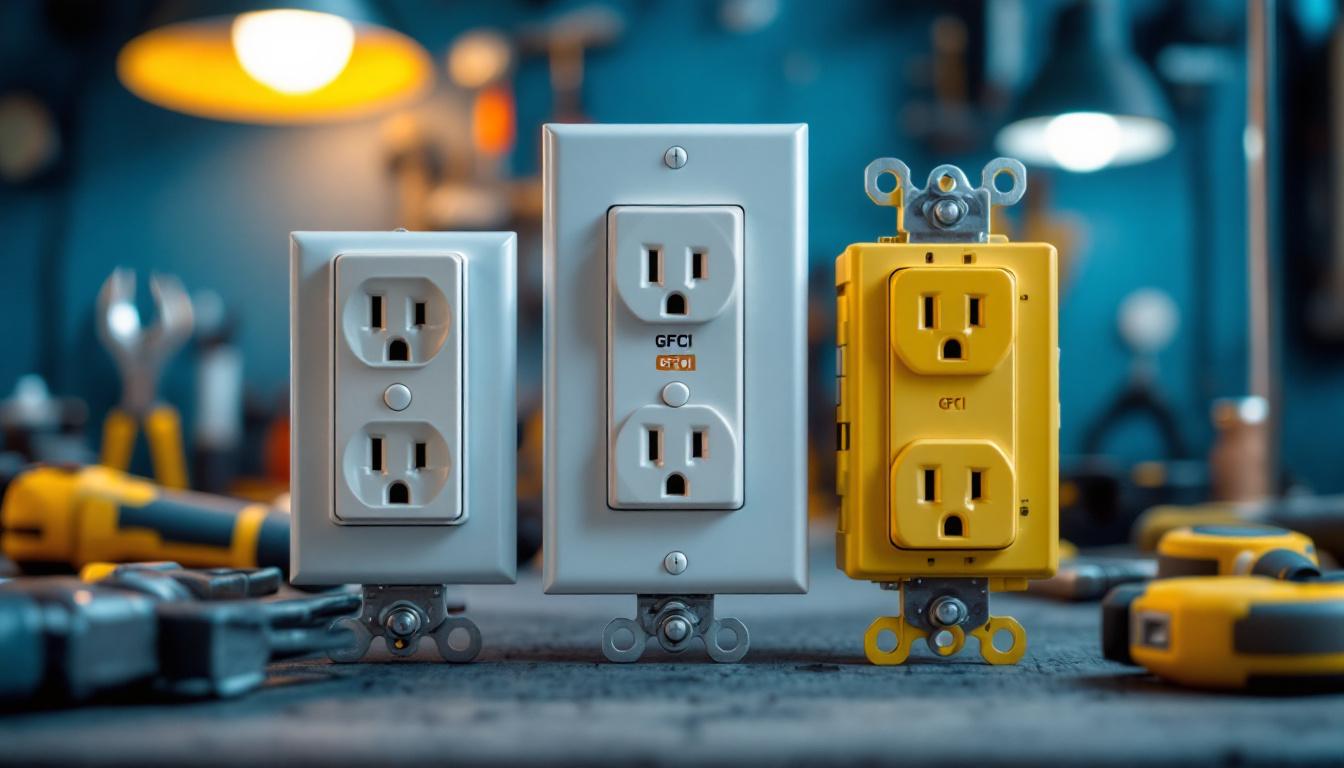
For lighting contractors, a thorough grasp of wall outlet types is essential not only for safety but also for ensuring compatibility and efficiency in electrical installations. Wall outlets serve as the critical interface between power sources and lighting fixtures, making it imperative to understand their design, function, and underlying electrical principles.
With the rapid evolution of lighting technology, including smart lighting and energy-efficient systems, the demands placed on wall outlets have also changed. Contractors must be equipped with knowledge about various outlet types, their voltage and current ratings, grounding methods, and installation standards to deliver reliable and code-compliant solutions.
Additionally, the rise of smart home technology has introduced new complexities to outlet types. Many modern lighting systems now require specialized outlets that can support Wi-Fi connectivity or integrate with home automation systems. For instance, outlets designed for smart bulbs often feature additional functionalities, such as dimming capabilities or remote control options. Understanding these nuances allows contractors to recommend the most suitable outlet types to their clients, ensuring that the lighting systems not only meet aesthetic preferences but also function seamlessly with the latest technology.
Moreover, it’s crucial for lighting contractors to stay updated on local electrical codes and regulations that govern outlet installations. Different regions may have specific requirements regarding the types of outlets allowed in residential and commercial settings. For example, GFCI (Ground Fault Circuit Interrupter) outlets are mandated in areas prone to moisture, such as kitchens and bathrooms, to prevent electrical shock. By being well-versed in these regulations, contractors can avoid costly mistakes and ensure that their installations are safe, compliant, and tailored to the unique needs of each project.
Wall outlets are designed to handle specific voltage and current levels, which directly impact the power that can be safely delivered to connected devices. In residential and commercial settings, common voltages include 120V and 240V, with current ratings typically ranging from 15A to 50A depending on the outlet type.
Understanding these ratings is crucial for lighting contractors to prevent overloading circuits, which can lead to overheating, equipment damage, or electrical fires. For example, a standard 15-amp outlet is suitable for most residential lighting fixtures, while higher-powered systems might require outlets rated for 20 amps or more. Moreover, the power rating, calculated as the product of voltage and current (P=VI), allows contractors to determine the maximum wattage that can be safely drawn from an outlet. This is particularly important when installing multiple devices on a single circuit, as exceeding the wattage can lead to circuit breakers tripping or, in worse cases, electrical hazards.
Grounding is a fundamental safety feature in modern wall outlets. It provides a path for electrical current to safely dissipate in case of a fault, reducing the risk of electric shock. Grounded outlets typically feature three prongs: two for the current-carrying conductors (hot and neutral) and one for the ground connection.
Lighting contractors must ensure that outlets are properly grounded and that the grounding system complies with local electrical codes. Additionally, many outlets now include built-in safety features such as Ground Fault Circuit Interrupters (GFCIs) and Arc Fault Circuit Interrupters (AFCIs), which protect against electric shock and electrical fires, respectively. GFCIs are particularly critical in areas where moisture is present, such as kitchens and bathrooms, as they can detect imbalances in electrical current and shut off power to prevent serious injuries. AFCIs, on the other hand, are designed to detect dangerous arcing conditions that can lead to fires, making them essential for bedrooms and living areas. As technology advances, smart outlets are also emerging, offering features such as remote control and energy monitoring, further enhancing safety and convenience in electrical installations.
The most prevalent outlet type in residential and commercial buildings is the standard duplex receptacle. These outlets accommodate two plugs and are typically rated for 15 or 20 amps at 120 volts. They are suitable for most lighting applications, including lamps, ceiling lights, and small fixtures.
Lighting contractors should be aware of the difference between 15-amp and 20-amp outlets, as the latter can handle heavier loads and are often used in kitchens, workshops, or other areas with higher power demands. Additionally, the positioning of these outlets is crucial; they should be installed at a height that is convenient for users while complying with local building codes. This ensures that they are easily accessible for plugging in various devices, from floor lamps to decorative lighting.
Ground Fault Circuit Interrupter (GFCI) outlets are designed to protect users from electrical shock by quickly shutting off power when a ground fault is detected. These outlets are mandatory in areas where water and electricity are in close proximity, such as bathrooms, kitchens, and outdoor locations.
For lighting contractors, installing GFCI outlets in appropriate locations is not only a code requirement but also a critical safety measure. Modern GFCIs can be integrated into lighting circuits to protect fixtures and users alike. It’s also worth noting that GFCI outlets come with a reset button, allowing users to restore power without needing to go to the circuit breaker, which can be particularly beneficial in high-traffic areas. Furthermore, educating clients about the importance of testing these outlets monthly can enhance safety and ensure they function correctly over time.
Arc Fault Circuit Interrupter (AFCI) outlets detect dangerous arcing conditions that can cause electrical fires. These outlets are increasingly required in residential bedrooms and living areas to enhance fire safety.
Lighting contractors should consider AFCI protection when designing and installing lighting circuits, especially in new constructions or renovations, to comply with safety standards and reduce fire risks. In addition, AFCIs can help prevent nuisance tripping caused by normal appliance operation, which is a common concern for homeowners. By educating clients on the benefits of AFCI outlets, contractors can promote a proactive approach to fire safety, ensuring that homes are equipped with the latest protective technologies.
Some lighting systems, such as theatrical lighting or industrial-grade fixtures, require higher voltage and current capacities. Specialty outlets, including 240V receptacles and locking connectors, are used to safely deliver power to these demanding applications.
Understanding the specifications and installation requirements of these outlets is vital for contractors working in commercial, industrial, or entertainment lighting sectors. For instance, in theatrical settings, the use of stage pin connectors allows for quick disconnection and reconnection of lighting fixtures, facilitating seamless changes during performances. Additionally, contractors should be familiar with the local regulations regarding the installation of these outlets, as compliance not only ensures safety but also enhances the reliability of the lighting systems in high-demand environments. Proper labeling and documentation of these specialized outlets can also aid in maintenance and troubleshooting, further supporting the longevity and functionality of the lighting installations.
The NEC provides comprehensive regulations governing the installation of wall outlets to ensure safety and reliability. Lighting contractors must be familiar with these guidelines, which cover aspects such as outlet placement, grounding, circuit protection, and outlet types for specific environments.
For example, the NEC mandates GFCI protection in wet areas and AFCI protection in living spaces. It also specifies the maximum spacing between outlets to prevent the use of extension cords, which can pose safety hazards.
While the NEC serves as the foundation, local jurisdictions may have additional amendments or requirements. Lighting contractors should stay informed about these local codes and integrate best practices into their work to ensure full compliance and optimal safety.
Regular training and certification updates are recommended to keep pace with evolving standards and emerging technologies in electrical and lighting systems.
The rise of smart home technology has introduced outlets with integrated communication capabilities, allowing remote control and automation of lighting systems. Smart outlets can be programmed to dim lights, set schedules, or respond to environmental sensors, enhancing energy efficiency and user convenience.
Lighting contractors must understand the electrical and communication protocols involved in these devices to ensure seamless integration and reliable operation within lighting installations.
Modern lighting systems prioritize energy efficiency, and wall outlets play a role in supporting these goals. Outlets designed to work with LED drivers, low-voltage lighting, and renewable energy sources are becoming more common.
Contractors who are knowledgeable about these innovations can advise clients on sustainable solutions that reduce energy consumption and environmental impact while maintaining performance and safety.
Before installing or upgrading lighting systems, contractors should thoroughly assess the existing wall outlet infrastructure. This includes checking outlet types, ratings, grounding status, and compliance with current codes.
Identifying outdated or damaged outlets early can prevent future issues and ensure that the lighting system operates safely and efficiently.
Choosing the appropriate outlet type requires consideration of the lighting fixture’s power requirements, environmental conditions, and safety standards. For example, outdoor lighting installations typically require weather-resistant outlets with GFCI protection.
Contractors should also consider future scalability and maintenance needs when selecting outlets to provide long-term value to clients.
Correct installation practices are critical to the performance and safety of wall outlets. This includes secure wiring connections, proper grounding, adherence to torque specifications, and careful mounting to prevent mechanical stress.
Using quality materials and following manufacturer instructions help avoid common pitfalls such as loose connections or corrosion, which can compromise lighting system reliability.
After installation, thorough testing of outlets and circuits is essential. This includes verifying voltage levels, grounding integrity, GFCI/AFCI functionality, and overall circuit continuity.
Employing advanced testing tools and documenting results can provide assurance of compliance and performance, reducing liability and enhancing client satisfaction.
For lighting contractors, mastery of wall outlet types and the science behind them is foundational to delivering safe, efficient, and code-compliant lighting solutions. From understanding electrical principles and safety mechanisms to navigating installation standards and embracing emerging technologies, this knowledge empowers contractors to meet the evolving demands of the lighting industry.
By applying best practices in outlet selection, installation, and testing, lighting professionals can enhance system reliability, protect users, and contribute to sustainable energy use. Staying informed and adaptable ensures that contractors remain valuable partners in creating well-lit, safe, and modern environments.
Ready to take your lighting projects to the next level? At LumenWholesale, we provide lighting contractors with the highest quality, spec-grade lighting products at unbeatable wholesale prices. Say goodbye to local distributor markups and hello to superior lighting solutions that meet the strictest industry standards. With our extensive selection, free shipping on bulk orders, and commitment to affordability and convenience, you’ll find everything you need to create safe, efficient, and code-compliant lighting environments. Elevate your lighting game with the best value in the business. Wholesale Lighting at the Best Value is just a click away.

Explore the transformative impact of solar panel lights on outdoor projects for lighting contractors.

Discover how QSSI is revolutionizing the lighting industry for contractors.

Discover the essential components of hanging light fixtures and why understanding them is crucial for lighting contractors.

Discover essential insights into Area LED Lights that every lighting contractor needs to know.